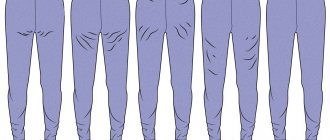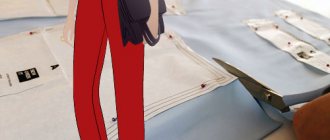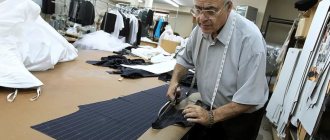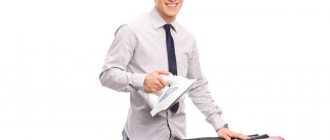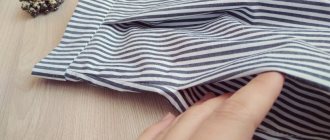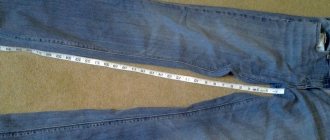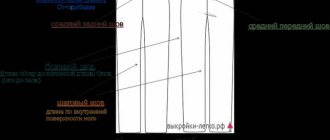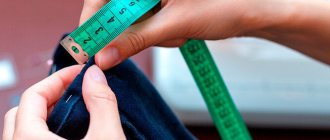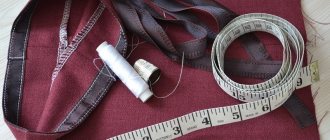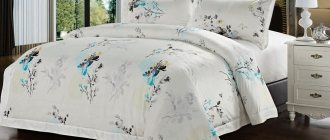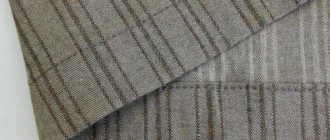The action that eliminates creases and lasses, while giving the correct shape to the trousers, is called wet-heat treatment. WTO gives off heat and moisture.
A lot of time is spent on wet heat treatment (WHT) when sewing trousers. Thus, it improves the shape of the product and the fit. Because at the end of the WTO, the pants are ironed and contracted under the buttocks and knees. The length of the product becomes shorter. But in the area after the knees, the process is reversed, the trousers stretch and therefore the length becomes longer. Ironing, or WTO, must be carried out for various parts or seams of a given product during the manufacturing process. Or gluing parts to give shape and volume. The procedure is carried out with a press or iron. Steaming a product is a labor-intensive process that takes up almost twenty percent of the total production time of the product.
Preparation of fabric, cutting and WTO of trousers
Preparing the fabric for cutting and subsequent wet-heat treatment (WHT) of product parts are important stages when sewing trousers. Use our tips and your trousers will not disappoint you after the first wash, they will have a perfect fit, and the fabric will not lose either color or texture. By the way, you can follow these recommendations when sewing any other clothes.
Checking the basic pattern
After the basic trouser pattern has been created, it must be checked for accuracy and alignment of the control lines.
Check the length of the side and crotch seams, knee, step, hip, and waist lines. Measure the half-waist and half-hip girth according to the pattern and compare with the measurements, taking into account the allowance for freedom of fit. Also an important measurement is the seat height, because this measurement affects the fit of the trousers. Insufficient Seat Height makes the trousers “small” and the fit low, and vice versa, an excessive length of Seat Height will create excessive freedom. To check this measurement on a pattern, measure the length of the center seam of the front and back halves of the trousers, then run a measuring tape between the legs from the front waist to the back waist and estimate the Seat Height using the measurement. If necessary, at this stage you can make adjustments to the basic pattern.
Preparing fabric for cutting
Before cutting, the fabric must be prepared appropriately so that after washing the product does not lose its appearance, the fabric does not “shrink” or, conversely, stretch, change color, etc.
Before cutting, lay the fabric right side out in one layer, check the fabric for defects (scuffs, holes, stains, bad coloring, thickening threads, etc.). Determine the front and back sides, the direction of the pile or pattern, if any. If during inspection of the fabric you find defects, they should be noted on the wrong side using chalk or contrasting snares. In this case, you need to get around these defects when cutting by placing the parts between them.
When moistened, some fabrics shrink (usually fabrics with natural fibers) along the length and width. In order to prevent shrinkage in the finished product, the fabric should be decated before cutting. To decatify, you need to moisten the fabric, iron it, and dry it. Some fabrics may change color during the decal process due to temperature or humidity. That is why, before decating the fabric completely, it is necessary to check how the fabric behaves on a small piece.
Use the table below to determine how to WTO your fabric before cutting.
Rice. 1. Methods of WTO fabric before cutting
Advice! To prevent the fabric from fading and to better retain its original shine, it can be soaked in water with the addition of vinegar: add 1 tbsp to 3 liters of cold water. l. vinegar.
Rules for cutting trousers
After WTO of the fabric, the cut must be folded in half along the grain thread. Pin the trouser parts onto the fabric so that the arrow lines are located along the grain thread. If there is no pile direction or pattern on the fabric, check matching is not required, the parts of the front and back halves of the trousers can be laid out in different directions to save fabric. Details of the belt, yokes, valances, facings, valves and other details of the trousers are laid out in the spaces between the main parts, observing the direction of the grain thread indicated on the parts.
Rice. 2. Layout of parts on fabric
For fabrics with a pile direction (velvet, corduroy), the parts are laid out on the fabric in only one direction. The direction of the pile should be from top to bottom. After the final placement of all the parts on the fabric, they are pinned, traced along the contour with tailor's chalk or a special disappearing marker, seam allowances are marked - 1.5 cm, along the bottom of the legs - 3-4-5 cm (depending on the model), mark all control lines and arrow lines. Then the parts are cut out along the contours of the allowances. Having removed the pattern, draw control lines completely and transfer them to the front side with basting snares.
Wet-heat treatment of trousers
After cutting out the parts of the trousers, on some models it is necessary to carry out a wet-heat treatment of the trousers - pulling and ironing individual sections of the trousers to give them a shape corresponding to the contour of the body. During the OBE process, the trousers are tightened under the buttocks and knees, and in the lower leg area, on the contrary, they are pulled back and lengthened.
Which trousers require wet-heat treatment?
WTO is necessary primarily for tight trousers, which are made from soft fabrics - wool, mixed fabrics. For fabrics with stripes or checks, WTO is not done, since such treatment may disrupt the pattern.
It is also better not to do WTO on wide and short trousers (it is enough to iron the crease lines), as well as on trousers made of cotton, silk, and viscose.
Advice! To make the fabric easier to iron and stretch, moisten the fabric through which you are ironing in a solution of 0.5 liters of water and 3 tbsp. l. vinegar. Before ironing, test the solution on a piece of fabric(!).
IMPORTANT! If the trousers have darts, then they must be stitched and ironed before the WTO. Place the uncut darts towards the middle cut and iron.
How to perform OBE on trousers?
Rice. 3. Scheme of WTO trousers
Fold the front and back halves of the trousers in pairs with the right sides inward, and turn the edges towards you. Moisten both halves of the trousers with the prepared solution and perform WTO as shown in Fig. 3.
Then bend the halves of the trousers lengthwise so that from the bottom sections to the knee line the step and side sections are aligned. Align the bottom cuts. Give the trouser halves their final shape.
How to iron correctly?
Good day, dear blog readers!
Probably the most commonly used proverb related to sewing: “The tailor shits, the iron irons!” It’s understandable, wet-heat treatment of the product, inside the process and final, are very important stages in sewing a product. And no less important than the sewing itself. The final appearance of the sewn product directly depends on the ironing work, on its sequence and correct execution.
It is quite difficult for many sewing lovers, and some even have no opportunity to allocate at least a small corner in the house for a full-fledged home sewing workshop.
And if they still somehow “scrape together” space in their home for a sewing machine and overlocker, then it can be very difficult to find a place to perform wet-thermal work.
I understand and sympathize! And yet, no matter how difficult and inconvenient it may sometimes be to adjust to the schedule of your family’s life, to constantly fold and lay out the main sewing tools, or often take time off from sewing to do small ironing work, but there’s nothing you can do about it, it needs to be done, and correctly , observing all WTO rules.
Wet-heat treatment technology.
To perform wet-heat work, you can, of course, get by with a minimal set of tools, which includes an iron with steam, and a flat, even, backed surface of a table, chair, etc.
You don't even have to buy them specially. After all, every lover of sewing also runs his own household. An iron and a place for ironing are simply necessary and integral attributes of a modern home.
And yet, for better performance of wet-thermal work, in the modern world there are other tools and devices. Some of them you can simply buy, others you can make yourself.
In order not to irreversibly damage the product, it is important to remember forever the very first rule of correct wet-heat treatment, which “reads”: “Find out the fibrous composition of the fabric being treated!”
You can read how to do this here.
Advice
Second. Having determined the fibrous composition on an iron or other modern ironing device, the temperature regime suitable for the fabric being processed is set.
But modern fabrics are, as a rule, a “symbiosis” of two, three, or more types of fibers. And then determining the fibrous composition becomes, to put it mildly, problematic.
But there is a way out of this situation. The effect of an iron or any other ironing device on the fabric being processed can be determined by ironing an unnecessary piece of the same fabric.
Thus, you can find out the maximum possible temperature level of exposure of the iron to a particular fabric, and also check them for color change and ability to deform (shrinkage).
3. Before performing WTO, all pins and basting lines must be removed. If the basting lines cannot be removed before fixing with an iron the folds, folds, all kinds of folds, etc. secured by the basting, then it is better to carry out the basting with very thin threads.
4. If before performing WTO you worked on fabric with marking tools, remember that the hot iron and its steam may cause lines, dots, marks, etc., made with marking tools to disappear.
Others, on the contrary, do not disappear, but are fixed on the fabric forever.
Therefore, follow the rules for working with marking tools and carefully read the instructions for their use.
5. If there are no special instructions in the sewing instructions for a specific model, you must adhere to the following WTO rule - all wet-heat work on the completed seam is carried out before the next seam intersecting with it is made.
note
Likewise, individual parts are connected to each other only after all the seams present on each of them have been completed.
Cutting out the trouser parts
First of all, the fabric must be prepared for cutting before it begins, that is, if necessary, decatified (processed to prevent shrinkage).
Carefully examine the front side of the fabric: the direction of the grain thread, pile, pattern, etc. Typically, the warp threads on a fabric run in the direction of the edge of the fabric.
If the fabric to be cut has a pile covering (plush, velvet, corduroy) or the pattern of the fabric is directed in one direction, then all the main parts are laid out in one direction.
On fabrics with a large pattern, the pattern pieces are laid out so as to preserve the pattern as much as possible or arrange it symmetrically.
On striped fabrics, the middle of all parts should coincide with the middle of the central strip. On checked and striped fabrics, the pattern pieces should be laid out so that the checks and stripes match at the places where they are joined.
As a rule, the layout on the fabric begins with the main parts, then additional ones are placed in the remaining gaps.
When laying it out on fabric, remember to leave room for seam allowances.
Be sure to check that the direction of the grain thread on each piece matches the direction of the grain thread on the fabric, securing each piece with pins to prevent movement during cutting.
Next, each part is outlined with chalk or soap, marking all control lines and cut out with seam allowances.
Seam allowances:
- for hem 4-6 cm
- on side and step seams 1-1.5 cm
- on the middle back seam 2-3 cm (if you need to widen the trousers)
- along the middle front line to a one-piece facing for a zipper 3-4 cm
- the width of the remaining allowances is 1 cm
Sequence of sewing trousers:
- Marking the position of pockets and darts;
- WTO (wet heat treatment) of the front and back parts of the trousers;
- Trying on trousers;
- Processing pockets and darts on the front and back of trousers;
- Zipper processing;
- Stitching side and step sections of trousers;
- Sewing the middle sections of trousers;
- Preparing a belt, belt loops;
- Processing the upper cut of trousers;
- Processing the bottom of the trousers;
- Final finishing of the product.
Stage 1. Pockets and darts
It is recommended to mark the position of the pocket and darts on the front and back of the trousers before any processing begins. After wet-heat treatment, this will be difficult to do, since the parts will acquire a given volume.
After marking the pocket and waist dart lines on one part, it needs to be transferred to the paired part. Then manually lay lines of straight stitches along the marked lines so that the marking lines are preserved during processing.
See pocket location options here.
Modeling
I begin production by adding model features to the base of the trousers.
modeling of straight trousers on a ready-made basis
Front lining
To improve the appearance, reduce the formation of folds in the abdomen and hips, stretching at the knees, and make the trousers more pleasant to wear, you can add a lining.
drawing of the lining on the front half of the trousers
Here is a set of patterns completely ready. I'm starting to sew.
Stage 2. Wet heat treatment of trousers (WHT)
Wet -heat treatment refers to the pulling and tightening of individual sections of trousers to give them a shape that matches the contours of the body.
For skinny trousers, WTO is necessary to a greater extent than for loose-fitting trousers. It is better not to subject fabrics with stripes or checks to WTO, since ironing and pulling the fabric will disrupt the pattern.
WTO can be avoided on wide or short trousers (it is enough to iron the crease), as well as when using fabrics made of cotton, viscose or silk.
WTO is not performed on trousers made from fabrics containing a large percentage of synthetic fibers.
WTO of the front halves of the trousers
1. Both front halves are folded with the right sides inward, aligning the control lines and the ironing lines.
2. At the same time, step and side cuts are pulled down on the two halves at the level of the calf from the knee line. The slack of tissue formed in this area is tightened to the arrow line.
The bulge in the hip area is slightly squished only for stretchy fabric and steep hips. If the thigh is very convex, then a pull-up is performed in the step area along the arrow line.
If the fabric stretches and when cutting there is a wave along the bow line, then in this area you can stitch it using a machine stitch.
3. Both halves of the trousers are turned to the other side and all operations are repeated.
4. Separate the front halves and fold each one along the ironing line with the wrong side inward and lightly iron along the fold.
The step and side cuts are aligned in the knee area so that there is no broken line. You can remove it by lightly pulling or adjusting it with scissors.
The ironing line is further tightened under the knee, and the side and step sections are further stretched. After this, when a beautiful shape of the trouser leg appears, the ironing line is finally ironed.
5. Check the equality of the front halves by placing them on top of each other and aligning the control lines.
WTO of the back halves of trousers
1. The back halves of the trousers are folded together with the right sides inward, aligning the control lines and the ironing lines.
2. At the level of the knee, the side and step sections are pulled back, the resulting slack in the tissue is pressed towards the arrow line.
At the level of the calf, the side and step cuts are ironed, and a pull is made along the arrow line.
Pull back the seat line, while ironing out the resulting slack in the area of the subgluteal fold.
If a bulge has formed in the area of the hip line, then it is ironed out or simply secured with machine stitching.
3. Both halves of the trousers are turned to the other side and all operations are repeated.
4. Each half is folded separately along the ironing line, inside out, aligning the control lines.
A slight pull is performed along the fold in the calf area, and the resulting or remaining slack in the seam area is ironed.
The knee area is tightened along the arrow, and pulled back at the seams.
Squeeze well in the area of the subgluteal fold.
5. Check the equality of the back halves of the trousers by placing them on top of each other, aligning the control lines.
After wet-heat treatment, check the coincidence of the lengths of the step and side sections of the front and back halves of the trousers by placing them one on top of the other.
Tense creases, folds
Release the required amount for a loose fit from the allowances.
Here it is necessary to lengthen the seat seam and deepen it.
If you incorrectly connect the cut parts of the trousers, or shift the control marks, then there will be irregularities in the fit. Displacement of any of the mounting notches along the knee line causes an imbalance in the trousers. The amount of error allowed can be determined by placing an auxiliary fold during fitting of the product.
Slightly shift the front halves relative to the rear ones along the crotch seam. Pick up the slack.
On the contrary, move the front halves down, relative to the rear ones. Only along the crotch seam.
WTO defects
An incorrectly performed WTO will also result in errors in landing.
Insufficient pull-down leads to the appearance of corner creases in the back fold of the trousers. Such creases are formed as a result of the tension of the fabric plane in the most protruding places of the figure (buttocks, calves, front thigh). The solution is to cut the trousers correctly.
Stage 3. Trying on trousers
Baste the trouser parts along the marked lines, while checking the alignment of all control marks.
The trousers prepared for fitting are put on, the fastener is pinned. Inspect and, if necessary, clarify or correct:
- the width of the trousers along the waist, hips, knees, bottom.
- length of trousers and depth of seat line
- correct position of the ironing line
- location of darts and their depth
- location of pockets
- belt position
After trying on the trousers, unroll the trousers; if you need to complete the WTO of all halves separately, check their equality and finally iron the ironing line.
Stage 4. Processing pockets and darts
Sew darts along the marked lines on the front and back halves of the trousers. First, iron the dart allowances to the edge, then iron them to the middle cuts, ironing the slack at the ends of the darts.
Overcast all sections of the main parts, except for the waist line.
Secure the waistline in each half of the trousers from stretching by making a fine stitch or gluing it with a strip of non-woven fabric.
Prepare the bottom of the trousers for sewing the instep and side seams. If you have a regular hem at the bottom, you can immediately glue the inside of the hem and its seam allowance, and if you have a hem with a cuff, you can glue it depending on the type of cuff.
Cutting and sewing
Anyone who once downloaded a diagram for constructing men's trousers using the Muller and Son method probably saw the line “Holding the WTO is MANDATORY!!!”
Yes Yes Yes! If your trousers do not fit, this means that this line was ignored by you. As a specialist who has sewn more than a thousand men's trousers, I take the liberty of saying that trousers using a method that can no longer be downloaded on our website are one of the best designs, but without WTO they will not fit the figure.
The WTO technology of men's trousers is sufficiently described in the literature, but we will still dwell on it again. First of all, I would like to dwell on where and how to do this. If you sew at home (and if you are reading this on the website, then this is the case), then I would like to draw your attention to the fact that there are three things necessary for a proper WTO - a table, an iron and water.
With water, everything is simple - take a spray bottle and moisten the front and back halves. Table (!) – an ironing board is not suitable for this, use a real (kitchen or similar) table. It’s more difficult with an iron - the required iron weighs 8 kilograms, and this is already completely ... exclusive. Why such a heavy iron? In order to properly fix the ironed areas of the halves. And it’s easier to pull with such an iron. Since no one has such an iron at home, there are two options for getting out of this situation: either do WTO for a long time (risking burning through the material), or put pressure on the iron with your weight. I suggest choosing the second path and, with some experience, you will quickly and correctly perform OBE on trousers.
Stage 7. Stitching middle sections
Turn one of the trouser legs wrong side out, and place the other face to face. Sew the middle sections in two lines, laying the second line at a distance of 0.1 cm from the first while pulling the seam back.
Press the seam allowances from the waistline until they reach the very bottom.
Belt loops are being prepared.
Fold the strip of fabric along the middle with the right side facing inward, align the cuts and stitch them.
Turn the piece right side out, place the seam on the inside in the middle and press. If desired, sew stitches along the edges of the belt loop piece. Cut the belt loop piece into six pieces.
The belt loops are placed two on the front of the trousers (between the folds and above the side pockets) and one on the back (above the darts at the waist).
Place the belt loops on the front side of the trousers, right sides down, and stitch along the top seam allowance.
Adjust the belt loops by placing stitches (tacks) at a distance of 0.6 cm from the seam line for attaching the belt to the trousers.
After attaching the belt, bend the belt loops along the line of the second stitching line, fold the upper sections of the belt loops inward and sew the folds onto the trouser waistband.
The upper section of the trousers is treated with a belt.
The bottom of the trousers, with or without a cuff, is finally hemmed.
The action that eliminates creases and lasses, while giving the correct shape to the trousers, is called wet-heat treatment. WTO gives off heat and moisture.
A lot of time is spent on wet heat treatment (WHT) when sewing trousers. Thus, it improves the shape of the product and the fit. Because at the end of the WTO, the pants are ironed and contracted under the buttocks and knees. The length of the product becomes shorter. But in the area after the knees, the process is reversed, the trousers stretch and therefore the length becomes longer. Ironing, or WTO, must be carried out for various parts or seams of a given product during the manufacturing process. Or gluing parts to give shape and volume. The procedure is carried out with a press or iron. Steaming a product is a labor-intensive process that takes up almost twenty percent of the total production time of the product.
Pulling back the step and middle cuts
The parts are laid out on the table with the cut being processed facing the person working. Pull back the step cut in its upper part by 2.0 - 2.5 cm, move it towards the side cut, and at the same time pull back the middle cut in the area of the largest notch. The resulting slack is ironed to the middle of the back half. The same techniques are repeated on the left side. The angle of the upper part of the step cut (about 12 cm along the step cut and 6 cm along the middle cut) is not pulled back.
Squeezing in the subgluteal area and lower leg area
The halves of men's trousers are separated and each folded separately with the front side inward so that in the area from the knee line to the bottom the side cut coincides with the step cut, the bottom cuts should be equal. The fold of each half of the trousers should be directed towards the top of the middle cut (at a distance of 5 - 8 cm from the top). In the upper part, the step cut should be spaced from the side cut by the same amount as the step cut of the front half in the upper part extended beyond the side cut (* - in the figure). Fold the fold of the parts (without ironing it) below the buttocks area (opposite the upper corner of the step cut, thereby obtaining a concave line).
Contrary to numerous statements, we recommend performing OBE on synthetic fabrics, but in a truncated volume - you can not touch the front half at all, and leave the item “Pulling the step and middle sections” on the back half.
Please also take into account that the entire volume of WTO must be done when sewing men's trousers using the pattern from our website. data-matched-content-rows-num=”4.2″ data-matched-content-columns-num=”1.2″ data-matched-content-ui-type=”image_stacked,image_stacked”
Why is the WTO done?
After cutting, it is necessary to carry out a wet-heat treatment.
ATTENTION! To get a good fit on your trousers, be sure to have your product processed!
After processing, you can change the dimensions of the product as intended. Give them shape, volume, according to the human figure. Thus, increasing the level of comfort of the product.
IT IS IMPORTANT TO KNOW! It is performed mainly by WTO, on narrow models, classical style.
Ironing is the reduction of edges after wet-heat treatment, and as a result, convex shapes are obtained. Pulling - lengthening the edges and obtaining concave shapes in a certain area of the product. When trousers are made from an unknown material, in order to avoid loss of color and strength, you must first check the effect of the iron on a small piece of fabric.
Ironing on natural fabric must be done through the fabric to avoid lasses.
Having finished processing, at the end, the trousers should be hung up and left to dry. Approximately fifteen to twenty-five minutes.
WTO for different types of fabrics
In the nineteenth century, classic-style men's trousers appeared. Designers only change the belt, pockets, fasteners, and other little things, making them according to fashion. High-quality trousers are the basis of a man's wardrobe. The fabric needs to be thick and of good quality. Fabrics on a natural basis, such as wool, linen, cotton, and others, when subjected to damp heat treatment, do not lose their fiber structure. Pants made from fabrics that contain synthetics, after processing, may lose their fiber structure. To achieve the correct fit, you can only use the cutting method. Skinny pants require a WTO more than wide ones. But a cell or strip may lose its pattern. To iron the arrows, you need to iron them in front from the waist to the bottom, and in the back from the hips to the bottom. The procedure does not need to be done on short pants and on fabrics such as viscose, cotton, silk.
Sequence of sewing trousers. Very detailed (Sewing and cutting)
Sequence of sewing trousers.
Very detailed ☝☝☝ Layout and cutting of trouser patterns on fabric 1. After constructing a drawing of trousers, it is checked for coincidence of control lines: bottom, knee, step, hip, waist. Check the measurements of SB and ST, taking into account their loose fit. Check the DPR measurement.
2. Before cutting begins, the fabric is decanted and only from the wrong side. Moreover, each type of fabric has its own processing method, since the shrinkage of different materials is not the same.
3. When cutting trousers, lay out the main parts of the front half of the trousers and the back half of the trousers on the main fabric, folded in half, face inward, so that the grain along the ironing line is preserved, and to save fabric, lay out the parts in a jack. The exception is fleecy fabrics.
After this, additional parts with shared threads are placed in the gaps as indicated in the modeling: yokes, valances, facings, flaps, belts.
4. To make sure that the direction of the grain thread of the main parts coincides with the pressing line, it is necessary to measure the distance from the edges of the fabric to the pressing line on the pattern in two or more places. By combining these points with a soap line, we get an ironing line on the fabric. If the fabric has a checkered stripe, then the ironing line is aligned with the selected stripe.
5. For fleecy fabrics (velvet, corduroy), the parts are laid out in one direction only. Most often, the pile goes from top to bottom, although the bright color is lost. Therefore, when placing the pile, you need to look at the fabric and the model.
6. The details of the patterns are pinned, outlined with soap, all control lines are marked and, having removed the pattern, they are drawn. After cutting, these lines are marked with spacer stitches or notches. The ironing line can be marked by ironing.
7. All allowances for parts when cutting are given as indicated in the diagram. An allowance of 2-3 cm along the seat line in the waist area is usually given in men's trousers, and in women's trousers when the pattern has not been adjusted and checked.
8. Baste and stitch the waist darts on the back half of the trousers and iron them towards the seat line.
9. Perform wet heat treatment
Wet heat treatment of trousers (WHT) Wet heat treatment refers to the pulling and ironing of individual sections of trousers to give them a shape that matches the contour of the body. As a result of the OBE under the buttocks and below the knees, the trousers become ironed and their length is reduced. In the area of the calf muscle, the trousers, on the contrary, are pulled back and lengthened.
For skinny trousers, WTO is necessary to a greater extent than for loose-fitting trousers. It is better not to subject fabrics with stripes or checks to WTO, since ironing and pulling the fabric will disrupt the pattern. The arrow line along the front half of the trousers is ironed from the waist to the bottom, and along the back half of the trousers from the hip line to the bottom. WTO can be avoided on wide and short trousers (it is enough to iron the crease), as well as when using fabric made of cotton, silk, or viscose.
To make the fabric easy to iron and stretch, you can soak the ironing iron in different solutions:
0.5 liters of water + 2 tablespoons of ammonia + 1 tablespoon of vinegar essence or 3 tablespoons of vinegar + you can add 1-2 teaspoons of PVA; 0.5 liters of water + 1 tablespoon of vinegar essence or 3 tablespoons of vinegar; 0.5 liters of water + 1 tablespoon of PVA. Note. Any of the solutions must first be checked on a piece of fabric to see if it is fading.
If there are darts in the trousers, then before the WTO, first sew them up, iron them well and iron them in the stops.
Wet heat treatment of the front half of the trousers 1) Lightly iron the creases of the left and right halves or mark with loose interfacing stitches.
2) Place the halves together face to face, pin together, aligning the control lines, darts and arrow lines.
3) Place the halves of the trousers on the table with the right or left up, but so that the side seams are laid towards themselves, and the waist is to the left or to the right.
4) The pull starts with side cuts in the area of the popliteal part (middle of the calf) from the knee line down. The bulge of tissue formed in the area of the calf muscle is tightened.
5) Unfold the front half of the trousers in incremental cuts and pull and tighten the area of the calf muscle in the same way.
6) The bulge in the hip area is slightly pressed only for stretchy fabric and steep hips. This stitching can be replaced with machine stitching along the seam allowance. If the fabric does not stretch or the thigh is flat, then the stitching is not done. If the thigh is very convex, then a pull is performed along the ironing line in the step area. The larger the thigh, the greater the draw.
7) If the fabric stretches and when cutting there is a wave along the bow line, then stitch in this area using a machine stitch.
8) Both halves of the trousers are turned to the other side and all operations:
or repeat (for poorly stretchable fabric); or complement (for WTO average fabrics); or they don’t (for obedient fabrics). 9) After removing the pins, each front half of the trousers is folded separately along the fold with the wrong side inward, aligning all the reference lines.
10) Place one of the halves on the table with the cuts facing you and first lightly iron the ironing line.
11) The step and side cuts are aligned in the knee area so that there is no broken line. You can remove it by lightly pulling it back or by adjusting the arched line with scissors.
12) The ironing line is further tightened under the knee, and the side and step sections are further stretched. After this, when the final beautiful shape of the trouser leg appears, the ironing line is finally pressed firmly.
13) These operations are performed separately on the right and left halves, trying to make them the same. Then, these halves are finally checked for equality by placing them on top of each other.
Wet heat treatment of the back half of the trousers 1) Lightly iron the creases of the left and right halves.
2) Place both halves face to face, pin down all the control lines of the knee, step, and hip.
3) Place the trousers on the table with the right or left side up, but with the cuts facing you.
4) To create a concavity in the area of the calf muscle, the step cuts are tightened, and to create a convexity along the arrows, a pull is performed.
5) The upper part of the step cut (knee area and above) is pulled back and ironed along the arrow.
After tightening the step cut of the back half of the trousers, make sure that its length is equal to the length of the step cut of the front half of the trousers.
6) Pull the seat seam. The guy is such that in the area of the largest recess (the area on which we sit) the seat line lengthens by 1-1.5-2-2.5 cm. It depends on the stretch of the fabric and the size of the pants.
Pulling back the seat line, the iron moves towards the waistline and slightly towards the buttocks, without disturbing the position of the trouser halves.
7) The resulting slack in the area under the gluteal folds is very well tightened, without affecting the bulge of the thigh.
8) Turn the trousers towards you with the side cuts and perform a small pull in the knee area, while simultaneously tightening the resulting slack in the knee area.
9) The area of the calf muscle along the side seam is ironed, then pulled along the ironing line.
10) If a bulge has formed in the area of the hip line, then it is ironed out or simply secured with machine stitching.
11) Both halves of the trousers are turned to the other side and all operations are either repeated, or slightly supplemented, or not performed, and only under the gluteal fold they are pressed as well as on the reverse side.
12) Remove the pins and fold each back half of the trousers along the arrow with the wrong side inward, while strictly aligning the line of the step and the knee.
Note : The pressing line in the back half of the trousers, depending on the drawing, is laid out starting from the knee line up to the waist - as it lies. An exception may be striped or checkered fabrics. Here the arrow follows these lines.
Wet-heat treatment of the main parts of trousers of different models and patterns
Wet-heat treatment is a critical operation in the manufacture of trousers; the appearance and shape of the finished trousers depend on it. When making trousers from fabric containing a large amount of synthetic fibers, wet-heat treatment is especially difficult, so the shape of the trousers for many models is created using construction.
Wet-heat treatment begins with ironing the seams of attaching extensions and darts. The back halves of the trousers are molded (if provided for by the design of the product) on presses with special pillows, folding the left and right halves with their front sides inward. The essence of molding on a press is to pull the cuts in the right places due to the convex-concave shape of the pillows.
In the absence of a press, wet-heat treatment of the front and back halves of trousers (to create the appropriate shape of the human body) during individual production is performed using an iron using the following techniques.
In trousers of narrow models and patterns down to the bottom, wet-heat treatment is performed on the front and back halves. Wet-heat treatment begins with the front halves.
Important
To obtain a concave line below the knee, the two front halves are folded with their right sides inward, the cuts are aligned, placing the bottom cut to the left, the side cut towards the worker.
The side cut is moistened, and the lower part of the halves is gradually moved with the left hand towards the step cut, and with the right hand the iron is moved along the side cut towards the bottom. The resulting slack in the fabric in the middle of the area from the knee line to the bottom in such trouser models is ironed.
Using the same techniques, the front halves of the trousers are pulled back along the step cut. Then the front halves are turned over and the wet-heat treatment is repeated on the side of the second half of the trousers.
The trouser halves are folded in the longitudinal direction so that from the bottom up to the knee line the side and step cuts coincide, and the fold from the knee line coincides with the upper front fold.
Along the fold of the front half of the trousers below the knee line, iron again if necessary to create a smooth concave line.
To secure the final shape, the parts are separated and the upper half is ironed again, folding it inside out along the fold. The folds are ironed through a moistened iron
The back halves of the trousers are folded with the right sides inward, aligning all the cuts. The parts are laid out with the side cut towards the worker, bottom to the right.
From the knee line to the bottom, the side cut is ironed, then the rear halves are turned over with the step cut towards the working one, and the bottom to the right and the step cut is ironed in the same way as the side one.
Advice
This tapping creates a convex shape along the fold of the piece onto the convexity of the calf muscles.
Continuing the wet-heat treatment of the rear halves, moisten the step (from the knee line up) and middle sections. To obtain the required shape on the convexity of the buttocks, these sections are pulled back.
The iron is directed along the step cuts from the knee line upward, while simultaneously moving the upper part of the step cuts away from the worker so that the cuts are located in a straight line. Without changing the position of the trouser halves, pull back the middle sections in the area of the largest notch.
How to properly wet-heat treat men's trousers
September 1, 2017
Wet heat treatment (WHT) plays a significant role when sewing trousers. WTO techniques make it possible to bring the cut details closer to the anatomical shape of the body and improve the fit of the trousers on the figure.
Men's trousers in our classic interpretation appeared at the beginning of the 19th century. Since then, their general concept has remained unchanged. Only the width of the trousers and small details are influenced by fashion: belt, tucks, pockets, etc.
Well-tailored trousers form the basis of a man's classic wardrobe. Just like a century ago, it is better to choose high-quality natural fabrics for sewing men's trousers.
Only fabrics consisting of natural fibers: wool, flax, cotton are subjected to wet heat treatment. Slight addition of synthetic fibers is possible. Fabrics with elastane are not subjected to WTO, as this may disrupt the structure of the fibers. Fabrics made from synthetic fibers cannot be pressed or pulled, so the cut details are not subjected to WTO and a good fit must be achieved using cutting techniques.
